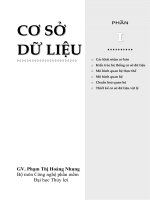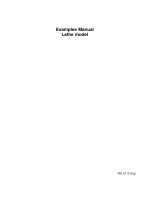C129 01
Bạn đang xem bản rút gọn của tài liệu. Xem và tải ngay bản đầy đủ của tài liệu tại đây (26.34 KB, 3 trang )
Designation: C 129 – 01
Standard Specification for
Nonloadbearing Concrete Masonry Units1
This standard is issued under the fixed designation C 129; the number immediately following the designation indicates the year of
original adoption or, in the case of revision, the year of last revision. A number in parentheses indicates the year of last reapproval. A
superscript epsilon (e) indicates an editorial change since the last revision or reapproval.
This standard has been approved for use by agencies of the Department of Defense.
1. Scope *
1.1 This specification covers hollow and solid nonloadbearing concrete masonry units made from portland cement, water,
and mineral aggregates with or without the inclusion of other
materials. These units are intended for use in nonloadbearing
partitions, but under certain conditions they may be suitable for
use in nonloadbearing exterior walls above grade where
effectively protected from the weather.
1.2 The text of this standard references notes and footnotes
which provide explanatory material. These notes and footnotes
(excluding those in tables and figures) shall not be considered
as requirements of the standard.
1.3 The values stated in inch-pound units are to be regarded
as the standard. The values given in parentheses are for
information only.
C 618 Specification for Coal Fly Ash and Raw or Calcined
Natural Pozzolan for Use as a Mineral Admixture in
Concrete2
C 1157 Performance Specification for Hydraulic Cement4
C 1209 Terminology of Concrete Masonry Units and Related Units3
C 1232 Terminology of Masonry3
3. Terminology
3.1 Terminology defined in Terminology C 1209 and Terminology C 1232 shall apply for this specification.
4. Classification
4.1 Nonloadbearing concrete masonry units manufactured
in accordance with this specification shall conform to one of
three weight classifications prescribed in Table 1.
NOTE 1—Concrete masonry units covered by this specification are
made from lightweight or normal weight aggregates, or both.
NOTE 2—When particular features are desired, such as weight classification, surface texture for appearance or bond, finish, color, fire resistance,
insulation, acoustical properties, or other special features, such properties
should be specified separately by the purchaser. However, local sellers
should be consulted as to the availability of units having the desired
features.
5. Materials and Manufacture
5.1 Cementitious Materials—Materials shall conform to the
following applicable specifications:
5.1.1 Portland Cement— Specification C 150.
5.1.2 Blended Hydraulic Cements— Specification C 595.
5.1.3 Hydraulic Cement—Specification C 1157.
5.1.4 Hydrated Lime, Type S—Specification C 207.
5.1.5 Pozzolans—Specification C 618.
5.2 Aggregates—Aggregates shall conform to the following
ASTM specifications, except that grading requirements shall
not necessarily apply:
5.2.1 Normal Weight Aggregates—Specification C 33.
5.2.2 Lightweight Aggregates—Specification C 331.
5.3 Other Constituents—Air-entraining agents, coloring
pigments, integral water repellents, finely ground silica, and
other constituents, shall be previously established as suitable
for use in concrete masonry and shall conform to applicable
ASTM standards or shall be shown by test or experience not to
be detrimental to the durability of the concrete masonry units
or any material customarily used in masonry construction.
2. Referenced Documents
2.1 ASTM Standards:
C 33 Specification for Concrete Aggregates2
C 140 Test Methods for Sampling and Testing Concrete
Masonry Units and Related Units3
C 150 Specification for Portland Cement4
C 207 Specification for Hydrated Lime for Masonry Purposes4
C 331 Specification for Lightweight Aggregates for Concrete Masonry Units2
C 426 Test Method for Drying Shrinkage of Concrete Masonry Units3
C 595 Specification for Blended Hydraulic Cements4
6. Physical Requirements
6.1 At the time of delivery to the purchaser, units shall
conform to the strength requirements prescribed in Table 2.
1
This specification is under the jurisdiction of ASTM Committee C15 on
Manufactured Masonry Units and is the direct responsibility of Subcommittee
C15.03 on Concrete Masonry Units and Related Units.
Current edition approved Aug. 10, 2001. Published October 2001. Originally
published as C 129 – 37. Last previous edition C 129 – 00a.
2
Annual Book of ASTM Standards, Vol 04.02.
3
Annual Book of ASTM Standards, Vol 04.05.
4
Annual Book of ASTM Standards, Vol 04.01.
NOTE 3—The purchaser is the public body or authority, association,
corporation, partnership, or individual entering into a contract or agreement to purchase or install, or both, concrete masonry units. The time of
*A Summary of Changes section appears at the end of this standard.
Copyright © ASTM, 100 Barr Harbor Drive, West Conshohocken, PA 19428-2959, United States.
1
C 129
TABLE 1 Weight Classification
Weight
Classification
Oven-Dry Weight of Concrete,
lb/ft3 (kg/m3)
Lightweight
Medium Weight
Normal Weight
Less than 105 (1680)
105 to less than 125 (1680 to 2000)
125 (2000) or more
8.2.1 Five percent of a shipment containing chips, not larger
than 1 in. (25.4 mm) in any dimension, or cracks not wider than
0.02 in. (0.5 mm) and not longer than 25 % of the nominal
height of the unit is permitted.
8.3 The color and texture of the units shall be specified by
the purchaser. The finished surfaces that will be exposed in
place shall conform to an approved sample consisting of not
less than four units, representing the range of texture and color
permitted.
8.4 Nonloadbearing concrete masonry units shall be clearly
marked in a manner to preclude their use as load bearing units.
TABLE 2 Strength Requirements
Average of 3 units
Individual unit
Compressive Strength
(average net area)
min, psi (MPa)
600 (4.14)
500 (3.45)
9. Methods of Sampling and Testing
9.1 The purchaser or authorized representative shall be
accorded proper facilities to inspect and sample the units at the
place of manufacture from the lots ready for delivery. At least
10 days shall be allowed for the completion of the tests.
9.2 Sample and test units in accordance with Test Methods
C 140 and Test Method C 426 when applicable.
9.3 Total linear drying shrinkage shall be based on tests of
concrete masonry units made with the same materials, concrete
mix design, manufacturing process, and curing method, conducted in accordance with Test Method C 426 not more than 24
months prior to delivery.
delivery to the purchaser is FOB plant when the purchaser or purchaser’s
agent transports the concrete masonry units, or at the time unloaded at the
worksite if the manufacturer or manufacturer’s agent transports the
concrete masonry units.
6.2 At the time of delivery to the purchaser, the total linear
drying shrinkage of units shall not exceed 0.065%.
6.3 Solid Units—The net cross-sectional area of solid units,
in every plane parallel to the bearing surface, shall be not less
than 75 % of the gross cross-sectional area measured in the
same plane.
7. Dimensions and Permissible Variations
7.1 Minimum face shell thickness shall be not less than 1⁄2
in. (13 mm).
7.2 No overall dimension (width, height, and length) shall
differ by more than 61⁄8 in. (3.2 mm) from the specified
standard dimensions.
10. Compliance
10.1 If a sample fails to conform to the specified requirements, the manufacturer shall be permitted to remove units
from the shipment. A new sample shall be selected by the
purchaser from remaining units from the shipment with a
similar configuration and dimension and tested at the expense
of the manufacturer. If the second sample meets the specified
requirements, the remaining portion of the shipment represented by the sample meets the specified requirements. If the
second sample fails to meet the specified requirements, the
remaining portion of the shipment represented by the sample
fails to meet the specified requirements.
NOTE 4—Standard dimensions of units are the manufacturer’s designated dimensions. Nominal dimensions of modular size units are equal to
the standard dimensions plus the thickness of one mortar joint. Nominal
dimensions of nonmodular size units usually exceed the standard dimensions by 1⁄8 to 1⁄4 in. (3.2 to 6.4 mm).
8. Finish and Appearance
8.1 All units shall be sound and free of cracks or other
defects that interfere with the proper placement of the units or
significantly impair the strength or permanence of the construction. Minor cracks incidental to the usual method of manufacture or minor chipping resulting from customary methods of
handling in shipment and delivery are not grounds for rejection.
8.2 Where units are to be used in exposed wall construction,
the face or faces that are to be exposed shall not show chips or
cracks, not otherwise permitted, or other imperfections when
viewed from a distance of not less than 20 ft (6.1 m) under
diffused lighting.
NOTE 5—Unless otherwise specified in the purchase order, the cost of
tests is typically borne as follows: if the results of the tests show that the
units do not conform to the requirements of this specification, the cost is
typically borne by the seller. If the results of the tests show that the units
conform to the specification requirements, the cost is typically borne by
the purchaser.
11. Keywords
11.1 concrete masonry units; face shell; flange; linear
shrinkage; nonloadbearing
2
C 129
SUMMARY OF CHANGES
Committee C15 has identified the location of selected changes to this standard since C 129-00a was published
in the 2001 Annual Book of ASTM Standards, Vol 04.05.
(1) In Section 5 on Materials and Manufacture, Specification
C 1157 was moved from Paragraph 5.1.2 to its own paragraph
and identified as hydraulic cement rather than blended cement.
The American Society for Testing and Materials takes no position respecting the validity of any patent rights asserted in connection
with any item mentioned in this standard. Users of this standard are expressly advised that determination of the validity of any such
patent rights, and the risk of infringement of such rights, are entirely their own responsibility.
This standard is subject to revision at any time by the responsible technical committee and must be reviewed every five years and
if not revised, either reapproved or withdrawn. Your comments are invited either for revision of this standard or for additional standards
and should be addressed to ASTM Headquarters. Your comments will receive careful consideration at a meeting of the responsible
technical committee, which you may attend. If you feel that your comments have not received a fair hearing you should make your
views known to the ASTM Committee on Standards, at the address shown below.
This standard is copyrighted by ASTM, 100 Barr Harbor Drive, PO Box C700, West Conshohocken, PA 19428-2959, United States.
Individual reprints (single or multiple copies) of this standard may be obtained by contacting ASTM at the above address or at
610-832-9585 (phone), 610-832-9555 (fax), or (e-mail); or through the ASTM website (www.astm.org).
3









